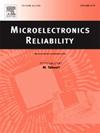Analyzing the electrical response of Au-GaAs Schottky diodes to proton irradiation at room temperature
IF 1.6
4区 工程技术
Q3 ENGINEERING, ELECTRICAL & ELECTRONIC
引用次数: 0
Abstract
This work investigates the electrical behavior of Schottky diodes fabricated by gold evaporation on n-type GaAs substrates. The substrates were cleaned using proton irradiation with a fluence of 1015 P/cm2 and energy range of 0.75–3 MeV. Current-voltage (I-V) analysis revealed significant changes in the electrical properties under various irradiation conditions. Key findings show that the Schottky barrier height decreases as proton fluence increases at constant energy, while it increases with rising proton energy at constant fluence. Additionally, the ideality factor, greater than unity, varies systematically with proton energy. These results highlight complex interactions at the Semiconductor-Metal (SM) interface, likely due to defect generation from proton irradiation. Re-analysis of experimental data confirmed these trends and provided deeper insight into the defect generation process. This study contributes to understanding radiation effects on semiconductor devices, offering insights crucial for optimizing radiation-hardened electronics.
求助全文
约1分钟内获得全文
求助全文
来源期刊

Microelectronics Reliability
工程技术-工程:电子与电气
CiteScore
3.30
自引率
12.50%
发文量
342
审稿时长
68 days
期刊介绍:
Microelectronics Reliability, is dedicated to disseminating the latest research results and related information on the reliability of microelectronic devices, circuits and systems, from materials, process and manufacturing, to design, testing and operation. The coverage of the journal includes the following topics: measurement, understanding and analysis; evaluation and prediction; modelling and simulation; methodologies and mitigation. Papers which combine reliability with other important areas of microelectronics engineering, such as design, fabrication, integration, testing, and field operation will also be welcome, and practical papers reporting case studies in the field and specific application domains are particularly encouraged.
Most accepted papers will be published as Research Papers, describing significant advances and completed work. Papers reviewing important developing topics of general interest may be accepted for publication as Review Papers. Urgent communications of a more preliminary nature and short reports on completed practical work of current interest may be considered for publication as Research Notes. All contributions are subject to peer review by leading experts in the field.
 求助内容:
求助内容: 应助结果提醒方式:
应助结果提醒方式:


